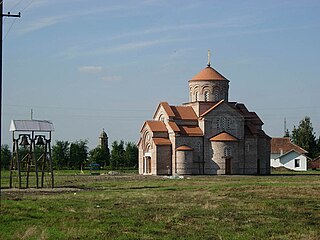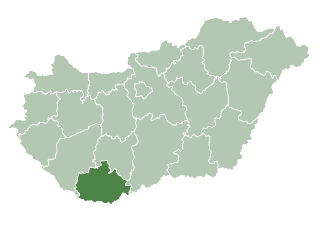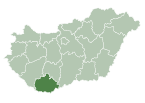
Oberwart is a town in Burgenland in southeast Austria on the banks of the Pinka River, and the capital of the district of the same name. With almost 8,000 inhabitants it’s the third largest town in Burgenland, after Eisenstadt and Neusiedl am See. Oberwart is the cultural capital of the small ethnic Hungarian minority in Burgenland, living in the Upper Őrség or Wart microregion.

The Danube Swabians is a collective term for the ethnic German-speaking population who lived in Kingdom of Hungary of east-central Europe, especially in the Danube River valley, first in the 12th century, and in greater numbers in the 17th and 18th centuries. Most were descended from earlier 18th-century Swabian settlers from Upper Swabia, the Swabian Jura, northern Lake Constance, the upper Danube, the Swabian-Franconian Forest, the Southern Black Forest and the Principality of Fürstenberg, followed by Hessians, Bavarians, Franconians and Lorrainers recruited by Austria to repopulate the area and restore agriculture after the expulsion of the Ottoman Empire. They were able to keep their language and religion and initially developed strongly German communities in the region with German folklore.

Plandište is a village and municipality located in the South Banat District of the autonomous province of Vojvodina, Serbia. The village has a population of 3,832, while Plandište municipality has 11,336 inhabitants. One of municipality's best known landmarks is Kapetanovo Castle, located in Stari Lec.

The Second Vienna Award, also known as the Vienna Diktat, was the second of two territorial disputes that were arbitrated by Nazi Germany and Fascist Italy. On 30 August 1940, they assigned the territory of Northern Transylvania, including all of Maramureș and part of Crișana, from Romania to Hungary.

Săliște is a town in Sibiu County, in the centre of Romania, 21 km (13 mi) west of the county capital, Sibiu. Declared a town in 2003, it is the main locality in the Mărginimea Sibiului area.

Bácsalmás is a small town in southern Hungary in the region of Bácska close to the border with the Vojvodina region of Serbia, with a population of 7,694 people.
Lajoskomárom is a village in Fejér County, Hungary.

Abaliget is a village in central Baranya County, Pécs District, in southern Hungary. Until the end of World War II, the majority of the Inhabitants was Danube Swabians, also called locally as Stifolder, because there Ancestors once came at the 17th century and 18th century from Fulda (district). Mostly of the former German Settlers was expelled to Allied-occupied Germany and Allied-occupied Austria in 1945–1948, about the Potsdam Agreement. Only a few Germans of Hungary live there, the majority today are the descendants of Hungarians from the Czechoslovak–Hungarian population exchange. They got the houses of the former Danube Swabians Inhabitants. It is located in the western Mecsek Mountains. The nearby Abaliget Cave and the area's lakes and hiking trails make it a popular tourist destination. Its population at the 2011 Census was 598.

Babarc is a village and municipality in Baranya county, Hungary. Until the end of World War II, the inhabitants were Danube Swabians, also called locally as Stifolder, because their ancestors were from Fulda (district). Most of the former German settlers were expelled to Germany and Austria in 1945–1948, as a result of the Potsdam Agreement. Only a few Germans of Hungary live there, the majority today are the descendants of Hungarians from the Czechoslovak–Hungarian population exchange. They occupied the houses of the former Danube Swabians inhabitants.

Illocska,, is a village in Baranya county, Hungary. Residents are Magyars, with a minority of Serbs and Danube Swabians. Until the end of World War II, the majority of the inhabitants were Roman Catholic Danube Swabians (Schwowe), their ancestors once came in 1790 from Nagyszékely and Gyönk villages to Illocska. Most of the former German settlers were expelled to allied-occupied Germany and allied-occupied Austria in 1946–1948, as a result of the Potsdam Agreement. Only a few Germans of Hungary live there, the majority today are the descendants of Hungarians from the Czechoslovak–Hungarian population exchange. They got the houses of the former Danube Swabians Inhabitants.

Udvar is a village in Baranya county, Hungary. This village is found near the Danube River. Until the end of World War II, the inhabitants were Danube Swabians, also called locally as Stifolder, because their ancestors once came around 1720 from Fulda (district). Most of the former German settlers were expelled to allied-occupied Germany and allied-occupied Austria in 1945–1948, about the Potsdam Agreement. Only a few Germans of Hungary live there, the majority today are the descendants of Hungarians from the Czechoslovak–Hungarian population exchange. They occupied the houses of the former Danube Swabians inhabitants.
Mecseknádasd is a town in Baranya county, Hungary. Until the end of World War II, the inhabitants were Danube Swabians. Most of the former German Settlers were expelled to Germany and Austria in 1945–1948, following the Potsdam Agreement. Only a few Germans of Hungary live there today. The majority are the descendants of Hungarians from the Czechoslovak–Hungarian population exchange.
Ivánbattyán is a village in Baranya county, Hungary. Until the end of World War II, the inhabitants were Danube Swabians, also called locally as Stifolder, because their ancestors once came in the 17th century and 18th century from Fulda (district). Most of the former German settlers were expelled to allied-occupied Germany and allied-occupied Austria in 1945–1948, as a result of the Potsdam Agreement. Only a few Germans of Hungary live there, the majority today are the descendants of Hungarians from the Czechoslovak–Hungarian population exchange. They occupied the houses of the former Danube Swabians inhabitants.

Kölked is a village in Baranya county, Hungary. Until the end of World War II, the inhabitants were Danube Swabians. Most of the former German settlers were expelled to Germany and Austria in 1945–1948, as a result of the Potsdam Agreement. Only a few Germans of Hungary live there, the majority today are the descendants of Hungarians from the Czechoslovak–Hungarian population exchange.

Lapáncsa is a village in Baranya county, Hungary.
Lippó is a village in Baranya county, Hungary. Residents are Magyars, Germans of Hungary, with minority of Serbs. Until the end of World War II, the majority of the inhabitants were Danube Swabians, also called locally as Stifolder, because their ancestors once came in the 17th century and 18th century from Fulda (district). Most of the former German settlers were expelled to allied-occupied Germany and allied-occupied Austria in 1945–1948, as a result of the Potsdam Agreement. Only a few Germans of Hungary live there, the majority today are the descendants of Hungarians from the Czechoslovak–Hungarian population exchange. They occupied the houses of the former Danube Swabians inhabitants.

Lánycsók is a village in Baranya County, Hungary.

Töttös is a village in Baranya county, Hungary. Until the end of World War II, the majority of the inhabitants were Danube Swabians, also called locally as Stifolder, because their ancestors once came in the 17th century and 18th century from Fulda (district). Most of the former German settlers were expelled to allied-occupied Germany and allied-occupied Austria in 1945–1948, as a result of the Potsdam Agreement. Only a few Germans of Hungary live there, the majority today are the descendants of Hungarians from the Czechoslovak–Hungarian population exchange. They occupied the houses of the former Danube Swabians inhabitants.
Újpetre is a village in Baranya county, Hungary. Until the end of World War II, the inhabitants were Danube Swabians, also called locally as Stifolder, because their ancestors once came around 1720 from Fulda (district). Most of the former German settlers were expelled to allied-occupied Germany and allied-occupied Austria in 1945–1948, as a result of the Potsdam Agreement. Only a few Germans of Hungary live there, the majority today are the descendants of Hungarians from the Czechoslovak–Hungarian population exchange. They occupied the houses of the former Danube Swabians inhabitants.

Egercsehi is a village in Heves County, Hungary. As of 2015, it has a population of 1,320, and 1,281 as of the 2021 estimate.


















